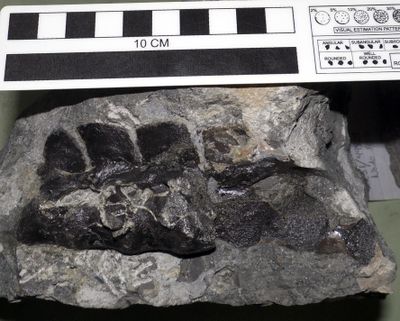Road work yields rare fossils
98 million-year-old specimens found in Idaho national forest

BILLINGS – Thanks to a road project in Idaho’s Caribou-Targhee National Forest last year, paleontologists discovered dump-truck loads of rare 98 million-year-old fossils – they just have to be chipped out of piles of the harder-than-concrete rock.
“Once we told them how significant it was, they left the rock there,” said L.J. Krumenacker, a Montana State University doctoral student who recently described the find during a Geological Society of America meeting in Bozeman. “This is kind of a little bonanza.”
The rocks, which were destined to be crushed and used for road fill, contain more dinosaur and terrestrial Cretaceous fossils than any other fossil site known in Idaho, Krumenacker said – more than 100, with the potential for hundreds more.
“It’s neat in that it presents an overall picture of the fauna back then,” said Dave Varricchio, an MSU paleontologist.
Krumenacker and his friend, retired Caribou-Targhee National Forest paleontologist Steve Robison, had recognized the potential of the area to hold the rare fossils since 2003. That was when they found small fossilized bones in a nearby road cut.
Such fossil finds in Idaho are rare.
“There’s just not the same types of rock outcrops or big badlands like in Eastern Montana,” Varricchio told MSU News services.
That’s because back in the Cretaceous period, much of Montana and Wyoming was under water as North America was split by a sea with the Rocky Mountain area above water in the west and the Appalachian in the east. Idaho was part of the uplands next to the ocean. As the Rocky Mountains rose, much of the rock got “messed up,” Varricchio explained.
Krumenacker’s theory is that the accumulation of bones was piled up in an ancient river channel. Now, that layer of Cretaceous rock is buried under Idaho’s forests and grasslands at elevations of about 7,000 feet. Varricchio praised Krumenacker for spending considerable time roaming the vast forest lands to search out the fossils.
“A lot of it has to do with his energy and ability to dash around the hills,” he told the Billings Gazette.
Now that the discovery has been made, the hard work has started: breaking the rock to free the fossils so they can be cleaned and identified. So far, the site has produced lots of little mammal teeth and the very first thing that Krumenacker saw, a vertebra from what could be a meat-eating dinosaur first identified in Utah, the Siats.
One of the more common fossils found at the site belongs to a burrowing plant-eating dinosaur, first described by Varricchio in a 2007 research paper, called the Oryctodromeus – a long name that means digging runner in Greek.
“We think of dinosaurs as big, but the most common animal is this sheepdog-size animal, Oryctodromeus,” Varricchio said.
The site also has produced a tooth from a plant-eating, duck-billed hadrosaur, the first evidence for this type of animal in Idaho; teeth from a large carnivorous theropod (biped) that may have been a fish eater; plant-eating armored nodosaurs (related to Stegosaurus and Triceratops); small theropods that may be feathered carnivores called dromaeosaurs; and eggshell from a large feathered oviraptorosaur similar to Gigantoraptor, Krumenacker said. The paleontologists also found the teeth and jaws of mammals, almost unknown in Idaho, as well as fossil fragments from turtles, crocodylians and fish.
“This will give us an idea of what else was running around back then,” Krumenacker said.
Because of the variety of fossils found, Varricchio said, it may represent an ecosystem different from what paleontologists have previously found in a coastal area.
Unfortunately, the find is not related to Krumenacker’s dissertation, so his work at the site will be limited for a while. There is the chance, however, that some students may work on the fossils this summer.
The site, which occurs in the Wayan Formation near Alpine, Wyoming, was named “The Robison Bonebed” in honor of Robison’s contributions to Idaho paleontology. The fossils will be curated in the John A. White Paleontological Repository at the Idaho Museum of Natural History in Pocatello. The fossils were collected under a permit issued by Caribou-Targhee National Forest, a requirement for all vertebrate fossils found on federal lands.